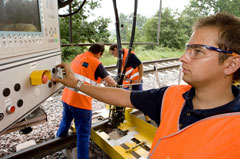An innovative system to reduce the noise emissions from railways has been developed by the German company Frenzel-Bau.
Called Durflex, it is based on the concept of stabilising the ballast stones under the track using an elastic polyurethane foam from Bayer MaterialScience.
The cavities between the ballast stones in the track bed are completely filled with Bayer's Bayflex liquid polyurethane foam by a rail-mounted vehicle, which prevents the stones from shifting as a result of the forces generated when a train passes over them.
This also increases the durability of the ballast superstructure and absorbs the structure-borne noise at the point where it is generated.
The company said that the system can be used to build new sections of track as well as upgrading existing stretches.
Durflex was successfully tested on two stretches of track in
Plans include construction of a longer demonstration track in

Bayflex liquid polyurethane foam system is injected straight into the gaps between the ballast stone and foams up to fill them completely




Red Bull makes hydrogen fuel cell play with AVL
Formula 1 is an anachronistic anomaly where its only cutting edge is in engine development. The rules prohibit any real innovation and there would be...